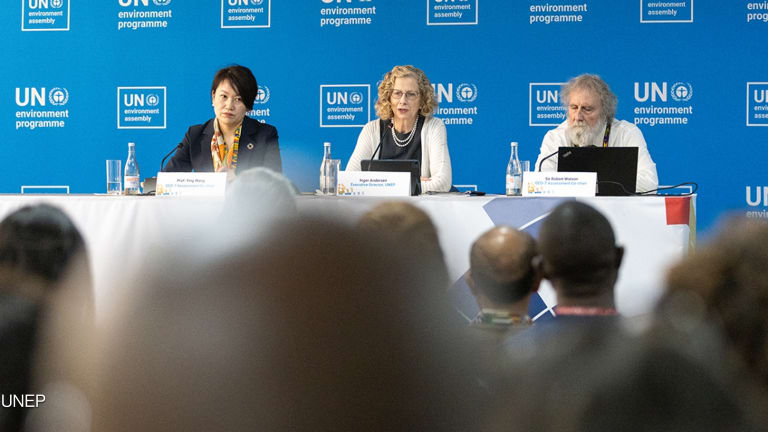
During last month’s meeting of the North Atlantic Treaty Organization, the intergovernmental military alliance between 29 North American and European countries, U.S. President Trump claimed credit for commitment by leaders to boost defense spending, ostensibly to avert threats from Russia and China, and portrayed that as his foreign policy success.
In the same week, the United Nations Framework Convention on Climate Change, the intergovernmental treaty that facilitates negotiations aimed at averting global warming, began its COP25 meeting with Trump initiating a yearlong formal process to exit the Paris climate agreement, relegating America’s participation in global negotiations on the climate crisis to the back seat.
Opinion: What we're missing in the climate migration story
As discussions increasingly turn to migrants fleeing the impacts of climate change, IWMI's Alan Nicol and Liza Debevec ask whether we are getting the story right.
Meanwhile, Australian Prime Minister Scott Morrison has maintained his climate skepticism and support for the coal industry in the midst of catastrophic wildfires, risking a damaging political storm. The fires have burned over 20 million acres, killed at least 28 people, and led to the death of a billion animals. Morrison has resisted measures to curtail greenhouse gases blamed for the wildfires, pointing to Australia’s long history of seasonal fires.
These are not unrelated stories. Efforts to solve climate and nature crises attract less attention and funding from world leaders, despite evidence that more people are increasingly affected by climate- and nature-related disasters than any other threat.
Until we change our stories, our hearts and minds will miss clear and present dangers.
Indeed, today’s serious social and ecological crisis demands that we develop new narratives to influence change globally. Too often, environmentalists believe that data alone should make people take action. We believe that the evidently dire state of the world’s climate should be enough to motivate people to reduce emissions and that knowledge of the alarming loss of wildlife should trigger waves of moral outrage and action.
But instead, people often feel overwhelmed and even detached or paralyzed by masses of data. We know we have science on our side when it comes to addressing our changing climate, but in order to trigger a meaningful mass movement for nature, we need people on our side, too. To achieve that, we must translate science into stories that resonate with people’s emotions and realities.
The power of good storytelling came to light with the surge in action on plastic pollution. For a long time, the environmental community had known that ocean plastics are dangerous to marine life. But it was only after the British Broadcasting Corporation’s series “Blue Planet II” aired that marine plastic pollution burst into public consciousness and policymakers took action. Professor Richard Thompson, who discovered microplastic ocean pollution, said, “In my view, a few minutes of coverage by Blue Planet II has done more to raise awareness than the decades of underlying research could ever have done alone.” Today, people frown at single-use plastics in ways never seen before.
Of course, we must choose our stories carefully to ensure their impact. The Greek philosopher Plato once said that stories and storytellers rule the world. In “The Republic,” he writes of the importance of educating the state’s guardians, its warrior class, through stories. “Our first business,” he argues, “is to supervise the production of stories, and choose only those we think suitable, and reject the rest.”
Likewise, the stories we tell could determine the success or failure of the environmental movement. One example is Well Told Story’s Shujaaz platform, which takes social, scientific, and business concepts that are otherwise inaccessible to ordinary people and shares them as relevant and authentic, purposeful stories. It shares them with East African youth through radio, social media, and comic books — which are more widely distributed than Marvel’s. It is empowering a new generation of keen young people and entrepreneurs in Kenya and Tanzania. The effect is a measurable impact on young Africans, empowered to take a stake in their own futures.
We need to learn how to use stories to bring life to facts and data. This is something 17-year-old Swedish school-striker Greta Thunberg has done well. She has brought home the realities of the climate crisis for young people and inspired millions of her peers to take action. Thunberg, a shy girl with pigtails, boycotted school in 2018 to demand that the Swedish government reduce carbon emissions in accordance with the Paris Agreement. This followed heat waves and wildfires during Sweden's hottest summer in about 260 years. Her action sparked a youth-led global protest movement, Fridays for Future, demanding action by politicians.
Rather than overwhelm people with data, stories can give rise to a narrative of hope. Thunberg and other nontraditional climate messengers, such as Extinction Rebellion, have made people sit up and take notice in a way that years of scientific data has failed to do. She became the public face of a powerful scientific story, emboldening a new generation to reject old assumptions and rules and instead live out the values that underpin successful societies.
“People and planet” has been a rallying cry for some years. 2020 offers unprecedented opportunities to secure major investments in our natural environment, with key global opportunities at the Convention on Biological Diversity’s conference in China, the U.N. secretary-general’s nature summit in New York, and the IUCN’s World Conservation Congress in France. It has, quite rightly, been termed a “super year” for nature.
Leading up to and during these events, we must remember that we have a responsibility to tell stories. As environmentalists, we need to recognize that we need new stories to reshape the direction in which our world is heading, whether the stories are about the conservation revolution in Namibia — with 71 communal conservancies and a staggering 43% of Namibia's land under conservation management — or the 15 conservancies that are protecting over 450,000 acres of the world-famous Masai Mara, a critical habitat for the great Serengeti-Mara wildebeest migration.
The contrasting approaches to NATO and UNFCCC meetings represent a political reality that bears no relationship to the world we see around us. Averting the crises of nature and climate change is as important as protecting humanity from the evils of military conflict. And it is central to building resilient and fairer economies. Remaining indifferent to the nature and climate crisis is indefensible and avoidable. It is time for political leaders to privilege narratives of hope over narratives of conflict.








